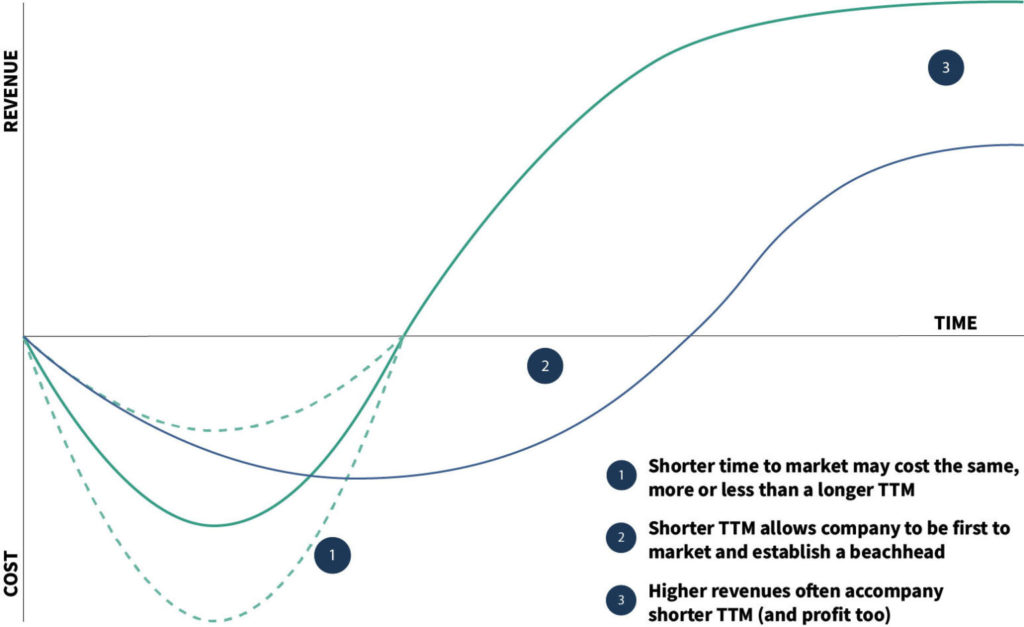Product managers, you’ve gone through the brainstorming, the conceptualizing, the designing, the building, the testing—all the major milestones on the product development journey. But you’re only halfway there. The rest of the journey is preparing your product to hit the market.
It’s exciting, but it also means there are many more steps ahead, and with them, obstacles to overcome. It’s never too early to begin thinking about taking your product to market, especially to counteract potential costs, be it time, money, or resources.
In this blog, we will go over the top 5 challenges product managers come across in the go-to-market process (and how to avoid them).
1. Slow time-to-market
Missing a single deadline can derail the original product-to-market timeline. Along with pressure from other departments to get things done, unexpected issues that come along with product photography or inventory tracking can set the initial launch back and lead to increased costs.
Not to mention, COVID-19 has put more work on the table. More than half of businesses surveyed reported that they became busier than ever, leading to further delays in the product management process. According to a McKinsey & Co study, going over budget by 50% is far better than being half a year late on releasing a product. The first results in a 4% loss of profits while a slow time-to-market cuts it by 33%.
To avoid a slow process, detailed planning and team-driven accountability are critical. Planning requires breaking up the roadmap into actionable steps, each with an exact deadline. Assigning specific tasks to defined teams or team members can encourage open communication and drive accountability, both key factors to pushing a project forward.
If you look at the diagram below, you can see that although a quicker time-to-market might cost less, more, or the same as the average time, it still propels the product to race ahead of competitors. The extra time buffer combined with other factors results in a higher likelihood of revenue and profit. An efficient product-to-market process empowers product managers to unlock revenue sooner, reduce costs, stay on top of new trends, and launch more products with roughly the same amount of resources.
One way to achieve progress quickly is by using a platform that consolidates product information from the start of development and allows your team to work out of a single source of truth. A product information management (PIM) system’ workflow includes templates you can use to propel your process forward, such as new product introduction workflows.
When using an NPI workflow, one department can briefly acknowledge a setback with a certain set of product data, while re-routing the workflow to allow other teams to continue moving the product forward while they wait.
When product information is centralized via tools like a PIM, it results in a quicker time-to-market process and speeds up sharing information with everyone, from partners to publishing on eCommerce stores.
2. Team misalignment
Did you know that 30% of product managers find navigating interdepartmental relationships most challenging?
Collaboration requires the perfect balance. Having too many meetings and review/approval requirements can waste more time, leading to little productivity. At the same time, efficient communication and brainstorming can save time and money, and improve work quality all around. For the most part, businesses suffer from disunited teams, leading to little collaboration. According to Deloitte, 39% of company employees report lacking this key tenant.
Each team within an organization has its own goals. While product managers see the bigger picture, they must persuade other teams with that vision to ensure end-product consistency. Otherwise, siloed efforts can arise, leading to errors or confusion. Some teams might not report issues until the very end of a project. Others might wait on the approval process from another department without notifying another team of the delay. Waiting on feedback is a major cause of product launch delays, according to 42% of marketers.
These issues can lead to errors in the product promotion phase:
- Low-quality product images
- Slow process time
- Invalid supplier information
- Wrong pricing from localization teams
- Missing product materials, details, or information for packaging, sales, and marketing
As a product manager, you’ll have to work with designers and engineers, set product functions and features, manage workflows, and pass on important information. Maintain these critical relationships with every department to bring your product vision to fruition.
What you can do is identify each team’s specific challenges, goals, needs, and bring them together in a clear objective. Communicate to teams how their respective goals contribute to the overall product vision. Aligned goals can help boost revenue 19% faster and unlock 38% more sales.
Team alignment allows for the improved centralization of product data product managers need to be ready for launch. Product managers can receive and send over logistics data from the logistics department, assets from the design team, dimensions to prepare for packaging, and so on. Managing it from creation to delivery reduces errors that could detract from the product’s success.
3. Understanding target audience
Some product managers may start with the product design without considering use cases until the very end of development. As most seasoned product managers know, you shouldn’t wait until it’s time to go to market before considering how to communicate product value to the target audience, or even what your target audience is. When this happens, it can lead to marketing content tossed in the trash, just like 60-70% of B2B content that fails to speak to the buyer persona.
Rather than having an intuitive, imaginary target buyer, product managers must base their profile on data-driven information. Start by launching research competitions to understand the product landscape and identify the value the buyer will receive from your product. This is essential to properly match the product’s value and introduction to market with the right audience. Never forget that there might be a difference between customer and user, so you need to consider both when preparing for launch.
Maintain a customer-centric lens when developing your product and when preparing its specs to share. This ensures relevancy between the target audience and product value, which will eventually be passed onto marketing teams and copywriters.
If you have multiple buyer personas, make sure your team has a solution for updating marketing content quickly and consistently across different channels, like a PIM.
4. Market alignment
Your product must be aligned with not only the target audience but also the overall context of the current market. This means taking into account market demand, trends, location, and overall climate from the time of production to the time of launch and factoring in these considerations to your step-by-step processes.
Being on top of market research is more important than ever in the post-COVID digital landscape. “As we look towards 2022,” says Kentley Insights Founder, Joe Newsum, “it will be critical to have insightful and timely market research to understand how these disruptions will impact your industry.”
To do this successfully requires in-depth research and ongoing communication between the product manager and the retail partners/dealers/channel partners. This part should be a continuous process that prepares for the final go-to-market.
Market alignment will require adaptability, but the quicker your launch process, the sooner you can catch any market shifts. This way, you can keep up with competitors and ensure your products maintain value up until the date of product release.
Speaking of which, make sure your product’s value is parallel to the market and target buyer. The value proposition is what product managers will share with marketing teams so they can accurately promote the product. While being product-focused is good, it’s meaningful to think about the use cases that will compel buyers to take action, choose your product over alternatives, and derive the most gains significant enough to take action.
5. Organizing sales & marketing campaigns
Before your product is ready to sell, you need to have product data, digital assets, all marketing content, and marketing collateral ready to go. An alarming 65% of sales reps struggle to gather the right product content to send to key leads.
Along the course of the product development process, it’s vital to keep track of all the data you receive from logistics and engineering, photography, etc. When held in different places and stored in multiple locations, it will be hard to efficiently share, especially if you have multiple channels and sales partners. Instead, a singular platform that holds all accurate data can improve publishing speed, as well as the accuracy of your product pages.
Before going to market, product managers must send the product information to dealers and retailers. Complete marketing materials and, in some cases, training and prep for internal sales are essential for ensuring a cohesive message across all sales channels.
A fusion between sales and marketing teams can vastly improve campaigns. Being on the same page regarding processes, goals, and tools is crucial. A whopping 96% of “well-aligned” companies share information over integrative tech systems. One way to accomplish this is through a brand portal or dealer portal. A brand portal houses digital assets, product catalogs, PDFs, and other marketing collateral in a secure location where outside partners can take what they need in a self-serve model.
Organized product data and digital assets are the driving force behind your product’s positioning statement. As always, the positioning should be about your audience, not the brand or the product.
Conclusion
Remember that after going to market, the work doesn’t stop there. Product managers must continue to update product information. For post-launch success, it’s good to have a process in place to change and update details in product information across a product’s life cycle. The easiest solution? An automated PIM tool that allows you to update product information once before publishing the update across all channels where the product lives.
These obstacles are difficult, but not impossible to overcome. Take control of your product’s success by tackling these challenges before they come, and you’ll be ready for product launch success!




